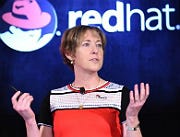Customers may be 'blissfully unaware' of the danger — but there are warning signs.

A company might think it’s successfully transforming into a cutting-edge, data-driven, AI-wielding digital business, then wake up one morning and find itself disrupted. For partners, the ability to identify customers at risk of being displaced is good for their longevity and your own.
We asked Margaret Dawson, Red Hat’s senior director of global product marketing, how to identify potential casualties. Dawson also weighed in on the urgency of digital; the CIO versus CMO issue; whether organizations really need a chief digital officer; and what key process, staffing and technology steps organizations must take to be successful with their digital business journeys.

Red Hat’s Margaret Dawson
Key takeaways for partners: A chief digital officer might not be the answer since disruption can be a slow drip — and companies with no vision of where they want to go are unlikely to get there.
Channel Partners previously talked with Dawson about the challenges women face in a male-dominated tech industry — and why progress seems so hard to come by.
Channel Partners: How can a company know if it is at risk of finding itself disrupted?
Margaret Dawson: What’s interesting is that you’re not going to know before it happens. That’s the irony of disruption, is that you have so many companies that until it happens, they were pretty blissfully unaware that they were about to be disrupted. So the thing that I always talk about when I’m speaking to CIOs or organizations is, just assume you’re going to end up getting disrupted by something you can’t see, that it may not be and usually isn’t someone who is a competitor today.
So rather than saying, “How do you know if you’re at the risk of it?” you are at risk. Every single organization – and in every industry of every size – is at risk right this minute. And so the question is, how do you get ahead of that? How do you look at your market, the technology, the way you’re running your business, the way you’re treating your customers? And if you act as though you’re already being disrupted, what are the things you would do differently?
Do that now. Don’t wait.
CP: What are signs you’re being disrupted?
MD: The things that we’re seeing are kind of the initial cuts or hurts … loss of customers, obviously, which is loss of revenue, or it’s just loss of velocity. Like if you’re a commerce company and someone comes out and has a new way of doing something. Maybe you still have your customers, but they’re now spending $5 per order as opposed to $20 per order because it just becomes so much easier with this other company. It can be a slow drip, or it can be a complete cut in the throat like we saw with an Uber situation.
The point of this is, and the reason we say digital disruption and digital transformation, is that so much of it is happening because of technology. And how it can hurt you is, all of a sudden, a competitor or another organization is using technology in a digital experience to reach customers to deliver services, to provide something that is in your market segment that completely changes the way that market is moving and delivering, communicating or servicing its customers. That’s what’s unique about this disruption: It’s all technology or digitally driven.
CP: Is it a good idea for organizations to have a chief digital officer? Would having one help in preventing disruption?
MD: I think a chief digital officer is an important role in a modern organization for a lot of reasons, from understanding that end-to-end digital journey for your customers to …
… tying everything together. We’ve had chief digital officers, but they tended to focus more on the e-commerce motion. If you think about digital literally being that entire universe, and how you tie all of these pieces together, and bring in big data and analytics, and all those things, I think it is a powerful [role].
However, to stave off disruption and to truly have this digital transformation, the entire organization needs to change the way they’re doing things.
IT needs to change, the business needs to change; there’s this transformation that needs to happen culturally, across processes, across resources — and how you are using those resources. It’s a multifaceted transformation that needs to happen and that touches everything. So that person may be the driver of some of those things, but the CIO is critical and so is everybody else.
CP: What key steps must organizations take to be successful in their digital transformations?
MD: Usually the first step that I talk about when I’m meeting with leaders is more about … their vision. So often we talk about, “oh, we’ve got to change, we’ve got to stave off disruption, but we don’t really have a vision of where we want to be or what is the company that we want to be, that’s going to succeed in this digital era” … and have everyone in the organization believe it. We undervalue the need for a vision, and I think it’s even more important in this case.
And then you really need to look across your entire environment, every part of your organization, to achieve that vision and to really be relevant. And not just today, but for the next few decades as we go through these constant transformations that are happening so quickly.
Part of that is embracing new kinds of technology and new ways of using technology. And open source is critical to that, how you embrace open source because you can move faster, you’re able to collaborate, you’re gaining the benefit of these communities, and you’re using the latest and greatest thing in order to be the disruptor instead of the disruptee.
Read more about:
AgentsAbout the Author(s)
You May Also Like


